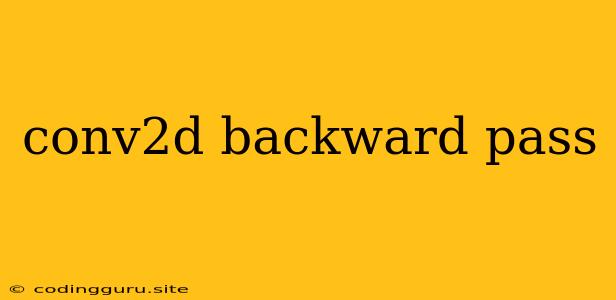Understanding the Conv2D Backward Pass: A Deep Dive
The convolutional layer, a fundamental building block in deep learning architectures, plays a crucial role in extracting features from input data. While the forward pass of a convolutional layer applies filters to input data, the conv2D backward pass is equally important in training convolutional neural networks. It involves backpropagating errors from the output layer through the convolutional layer to adjust its weights and biases.
What is the Conv2D Backward Pass?
The conv2D backward pass, also known as backpropagation for convolutional layers, is the process of calculating gradients for the weights and biases of a convolutional layer during training. This is a critical step in the optimization process, as it helps to update the model parameters to minimize the error between the predicted output and the actual target values.
Why is it Important?
Understanding the conv2D backward pass is essential for several reasons:
- Training Deep Learning Models: The conv2D backward pass is the core mechanism that allows us to train convolutional neural networks effectively. It enables the model to learn from its mistakes and improve its performance on the given task.
- Optimizing Model Parameters: The calculated gradients during the conv2D backward pass guide the optimization process, helping the model to adjust its weights and biases to reduce the error and improve accuracy.
- Understanding the Gradient Flow: By understanding how the gradients flow through a convolutional layer during the conv2D backward pass, we can gain insights into the model's learning process and identify potential issues, such as vanishing or exploding gradients.
How does the Conv2D Backward Pass Work?
The conv2D backward pass involves calculating the gradients for the following:
- Weights: These are the filters used in the convolutional layer.
- Biases: These are the constant values added to the output of the convolution operation.
- Input Feature Maps: These are the inputs to the convolutional layer, which are transformed by the filters to produce the output feature maps.
The calculation of these gradients is based on the chain rule of differentiation, which allows us to compute the gradients of a complex function by breaking it down into simpler components. Here's a breakdown of the steps involved:
- Calculating the Output Gradient: The conv2D backward pass starts with the gradient of the loss function with respect to the output feature maps of the convolutional layer.
- Propagating the Gradient Through the Activation Function: The output gradient is then backpropagated through the activation function (e.g., ReLU) used in the convolutional layer.
- Calculating the Gradient of the Convolution Operation: The gradient is then used to calculate the gradients for the convolution operation. This involves convolving the output gradient with the flipped kernels of the convolutional layer.
- Calculating the Input Gradient: The gradient for the input feature maps is calculated by convolving the output gradient with the kernels of the convolutional layer.
- Updating the Weights and Biases: Finally, the gradients of the weights and biases are used to update these parameters using an optimization algorithm, such as gradient descent.
Example
Imagine a simple convolutional layer with a single filter. The filter is applied to the input feature map to produce an output feature map. In the conv2D backward pass, we calculate the gradients of the filter, the bias, and the input feature map.
The gradient of the filter is calculated by convolving the output gradient with the input feature map. The gradient of the bias is simply the sum of the output gradient. The gradient of the input feature map is calculated by convolving the output gradient with the flipped filter.
Tips and Tricks
- Understand the Convolutional Layer: Before delving into the conv2D backward pass, it's crucial to have a solid understanding of how convolutional layers function in the forward pass.
- Use Visualization Tools: Visualizing the gradients during the conv2D backward pass can provide valuable insights into the learning process and identify potential issues.
- Explore Different Optimization Algorithms: The choice of optimization algorithm can significantly impact the efficiency of the conv2D backward pass. Experiment with different algorithms to find the best one for your specific task.
Conclusion
The conv2D backward pass is a vital component of training convolutional neural networks. Understanding its workings is essential for effectively training deep learning models and optimizing their performance. By backpropagating errors and updating the model parameters, the conv2D backward pass plays a crucial role in enabling convolutional neural networks to learn complex features and patterns from input data.
